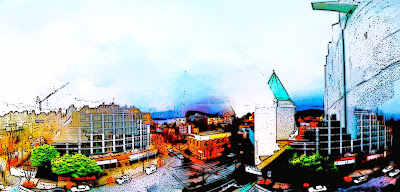Dickens and Christmas*
St. James' Victorian roots are splendidly evident at this time of the year with its Advent activities, greenery, music and especial focus on children; and yet we need to be planted in a goodwill beyond our immediate gaze and needs. A recent re-reading of A Christmas Carol by Charles Dickens brought to mind the very people in our parish that our Bidding Prayer asks us to remember.
Dickens is often blamed for inventing the material aspects of Christmas that hamper the season to ever elevated degrees. But he was not working in a vacuum, and there were other forces contributing to the veritable saving of the Christmas festival which had been mostly diminished to one day out of a long year. It was his understanding of spirituality and morality as dual participants in the older traditions alongside the re-imaging of holiday customs that made a lasting impact. Together they included family, church, and charity, childhood memories and cultural nostalgia. His sentiments as portrayed in A Christmas Carol contributed to the cultural tapestry we have all inherited and embraced.
By 1840 and with a new young queen on the throne, Great Britain was at a confident stage of empire building and indirectly ruled the world through economic influence and control of the sea. There were also numerous liberal movements gaining a foothold in the public imagination, including parliamentary reform, free trade, collective bargaining, Catholic emancipation, the Oxford Movement, abolishment of slavery, restraints on child labour and local government and postal reforms as well as developments in science, medicine, exploration, and the railroad.
A Christmas Carol is essentially a spiritual fairy tale about the value and joy of giving. It was written alongside Martin Chuzzlewit and published in December 1843 primarily, if ironically, because Dickens needed to make money in order to support his growing family and tangle of extended relations. It was an instant success although not as profitable initially as planned due to its high quality at a reasonable price. Within ten years he was giving lectures and readings, which often included his best-loved Christmas tale, all of them very much associated with his philanthropic activities and his belief that literature could advocate for the betterment of all.
Dickens remains an intercessor between an industrial, material, and increasingly secular time and the humanity that he wanted to uplift. The focus on children and charity is especially and obviously reflective of Christ's continued presence in the season. Every year his tale seeks to re-invigorate and maintain an important sacred and secular event. His contributions to what we know as Christmas are now well established, and, in the words of G. K. Chesterton, we can note that "whether the Christmas visions would or would not convert Scrooge, they convert us."
In his own words Dickens tells us that with regard to the rehabilitated miser, "He knew how to keep Christmas well." The portrayal is effective because it is so visceral. Christ is present within the redemptive power of kindness and charity -- that is the author's emphasis. As a literary journalist, social reformer, and moralist, Dickens bids us not for just one day, but for all the days of the year.
 | |||
| No. 7373 - 20 Dec 2013 - 09:05:58 |
* PAX: No. 28, Christmas © 2015






























